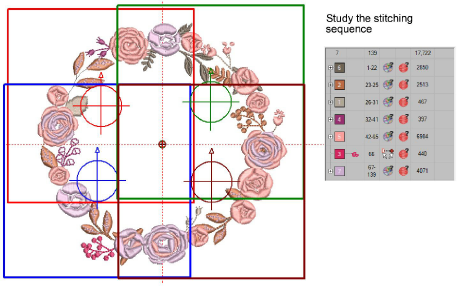
Es siempre importante establecer la secuencia de bordado en forma que los objetos en primer plano se borden después que aquellos en el plano de fondo. Conocer la secuencia de bordado le ayuda a colocar aros en el mejor orden posible. Use la herramienta Lista color-objeto para estudiar la secuencia de bordado.

Otra herramienta útil es Simulador de puntada. Al ejecutarlo, busca asegurarse de que los objetos divididos se dividan en encuadres de aros adyacentes (tanto en términos de posición como de secuencia de colocación de aros) y de que el objeto comience a bordarse en el primero de los aros.
Aunque la correcta colocación de aros reduce el número de encuadres calculados, en ocasiones la secuencia de bordado puede no ser la ideal. Puede concluir que la única forma de reducir el número de encuadres sea re-secuenciar el diseño mismo. Tenga en cuenta lo siguiente:
3Los diseños comerciales creados para un solo aro han sido por lo general secuenciados para reducir el número de cambios de color.
3Al agrandar un diseño de stock hasta el punto de requerir encuadres múltiples puede requerir ajustar la secuencia de bordado.
3Como una operación de bordado dada puede usar solo un tamaño de aro, escoja un aro que abarque el objeto más grande en el diseño.
3De igual manera, use el aro más grande disponible para el modelo de máquina específico.